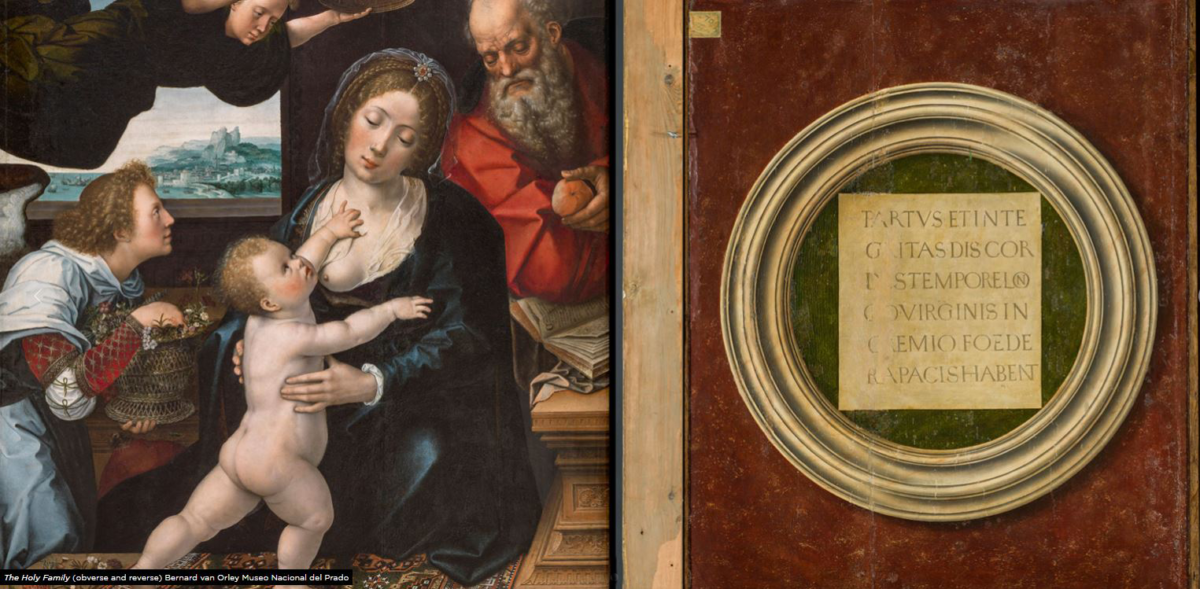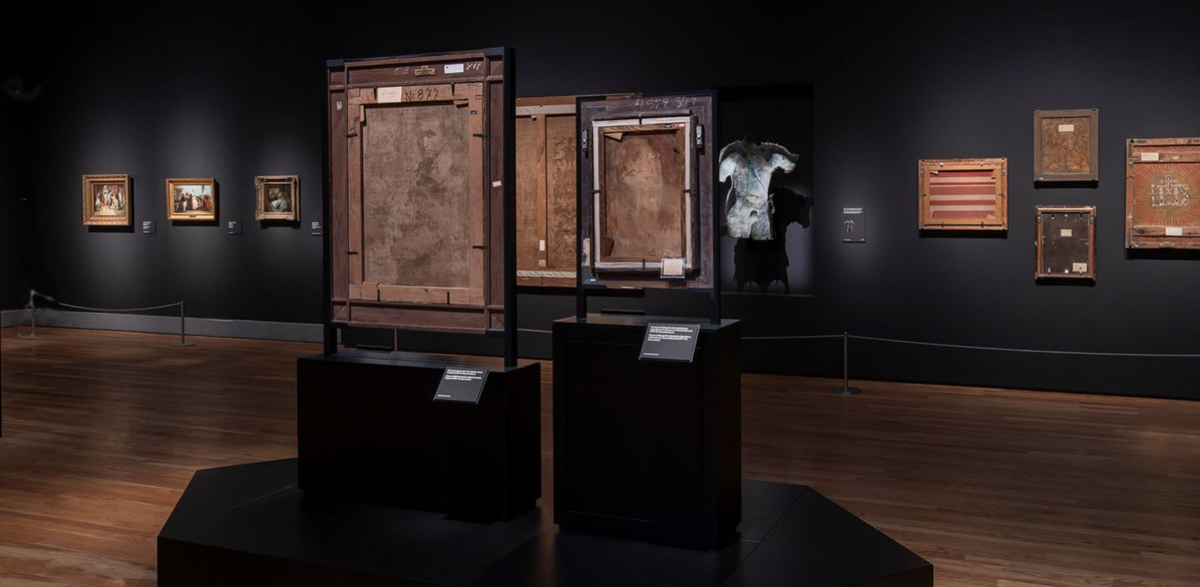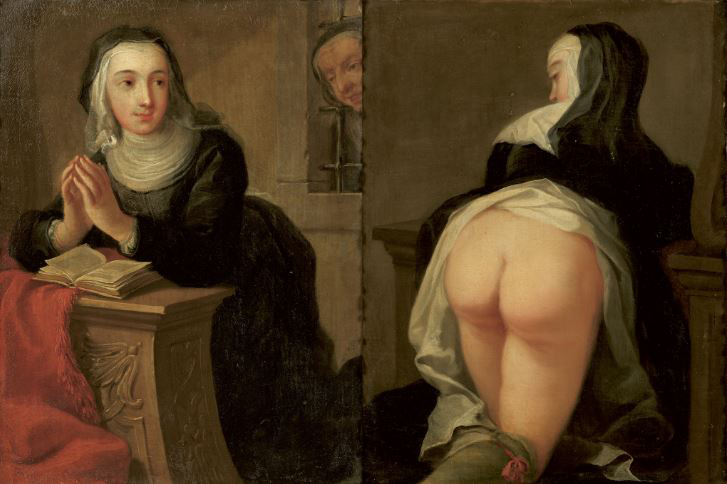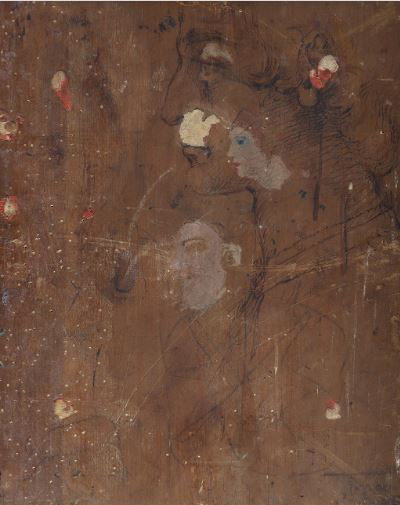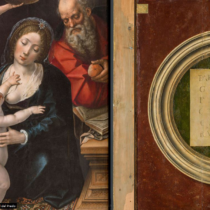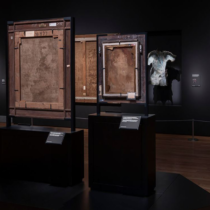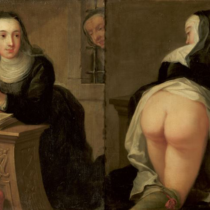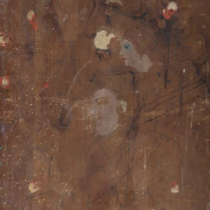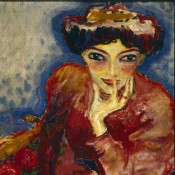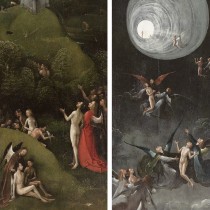Until 3 March 2024 the Museo Nacional del Prado and Fundación AXA are undertaking a journey that moves beyond the surface of artistic masterpieces to allow for the contemplation of a fascinating reality: the hidden side of the work of art, its reverse.
Alongside works from the Prado’s own collection, which have been the subject of a lengthy process of research on their other sides that is now presented in the exhibition, On the Reverse also includes generous loans from other national and international institutions. They include Assemblage with Graffiti by Antoni Tàpies from Fundación Telefónica, Cosimo I de’Medici by Bronzino from the Abelló Collection, Self-portrait as a Painter by Van Gogh from the Van Gogh Museum, Amsterdam, Artist in his Studio by Rembrandt from the Museum of Fine Arts, Boston, and The empty Mask by Magritte from the Kunstsammlung Nordrhein-Westfalen, Düsseldorf, giving a total of around 100 works on display.
Curated by artist Miguel Ángel Blanco, for the installation of the exhibition Rooms A and B of the Jerónimos Building have been painted black for the first time. On the Reverse takes the form of an open survey which gives maximum freedom to the spatial relationship between the works, devoid of any hierarchy or chronological ordering and including the presence of creations by contemporary artists such as Vik Muniz, Sophie Calle and Miguel Ángel Blanco himself, represented by three of his box-books from the “Library of the Forest”.
Taking his starting point from a contemplation of Las Meninas, in which the reverse of the vast canvas on which Velázquez is working occupies a large portion of the pictorial surface, the exhibition’s curator, contemporary artist Miguel Ángel Blanco, proposes an unusual approach to painting by turning the works around in order to encourage visitors to establish a new and more complete relationship with the artists who created the approximately 100 works on display.
Numerous studies have been undertaken to date on individual works which have interesting backs for different reasons and some museums have explored this aspect in a partial manner through small exhibitions focused on the reverse of works in their collections. However, with the collaboration of Fundación AXA it is the Museo Nacional del Prado that is now approaching this subject with the necessary ambition. In addition to undertaking a complete reassessment of the backs of works in its collections, the Museum has also located examples in some of the world’s leading museums which reveal how an appreciation of works of art is enriched when their contemplation is not limited to the front.
The exhibition, which is structured into sections that focus on different aspects relating to the reverse of works, includes artists never previously seen at the Prado, among them Van Gogh (1853-1890), René Magritte (1898-1967), Lucio Fontana (1899-1968), Pablo Palazuelo (1915-2007), Antoni Tàpies (1923-2012), Sophie Calle (1953), Vik Muniz (1961), Michelangelo Pistoletto (1933), José María Sicilia (1954), Wolfgang Beurer (active 1480-1504), Louis-Léopold Boilly (1761-1845), Carl Gustav Carus (1789-1869), Vilhelm Hammershøi (1864-1916), Martin van Meytens (1695-1770), Wallerant Vaillant (1623-1677), Ernst Ludwig Kirchner (1880-1938), and Max Liebermann (1847-1935).
The exhibition opens with The artist behind the canvas, crossing that dimensional threshold to which Velázquez draws our attention with the enigmatic reverse of the canvas he is painting in Las Meninas, with a section devoted to depictions of backs of paintings in artists’ studios. They frequently portrayed themselves located behind one, but even when these backs are not so directly associated with the artist’s activity they acquire a prominent presence in the setting as objects of special significance in painters’ studios.
The depiction of the back returns in This is not a reverse, a section which paraphrases Magritte in order to bring together various trompe l’oeils that represent backs of paintings. This meta-artistic subject reveals the enormous significance that the hidden side of works could acquire for artists, leading them to imitate the annotations, inscriptions, drawings, etc, habitually found on picture backs.
One of the elements that makes up the pictorial support is the subject of The stretcher as cross, the exhibition’s third section. This concealed structural element normally takes the form of a wooden cross which can be used to carry the painting from one place to another. When, in a habitual, everyday action that also emphasises the three-dimensional status of the work which this exhibition analyses, an artist picks up the cross of the stretcher in order to move the work in the studio or take it outside for the purpose of painting outdoors he/she is performing a type of “Via Crucis” which symbolises the effort and difficulties of artistic endeavour.
The exhibition’s central section, B-sides, focuses on works that can be termed “two-sided”. Here the back has its own artistic status and complements the principal image in various ways. It may feature the back of a figure seen from the front on the other side, a landscape or allegorical scene that modifies the meaning of the principal representation, heraldic information, associated religious themes, portraits, and more. Continuing this theme, the section The hidden side includes various works in which the back reveals traces of the creative process in the form of drawings, geometrical designs or expressive whimsies.
More information on the back looks at a classic problem in painting. Although word and image coexisted relatively easily until the Middle Ages, a moment arrived when artists entrusted all the weight of the narrative to the latter. Furthermore, when they needed to convey information, identify subjects or individuals or include additional information or commentaries on the execution of the work they almost invariably wrote on the back.
In some cases information has been added to backs at a later date in the form of labels and stamps or seals that help us to trace the history of the works: the collections they belonged to, the palaces they adorned, their changes of location and any restoration undertaken on them.
In other cases, as seen in Ornaments and ghosts, the backs reveal stories contained in the works’ actual materials: textiles that had domestic uses or patterned weaves that contain unintentional ghosts which appear when oil soaks into the cloth. In addition, the section Folds, cuts and cutouts shows how old restorations and alterations made to adapt paintings to new locations or functions are visible on reverses that include repairs, cuts and folds which result in part of the image being relegated to facing the wall.
It is easy to simplify the experience of “facing” a painting to a question of fronts: the work’s and the viewer’s. Looking at a painting implies locating ourselves before it with our “front side”, where our eyes are located. However, for some time now the experience of art has been understood as something more physical; our entire body in all its dimensions participates in it. In fact, in both depictions of artists working in their studios and in images of the public looking at art in museums and exhibitions these figures are often seen From behind, in front of the painting.
Finally, Nature in the background investigates the unusual or less common materials that have been used over the centuries as the supports for paintings in the Museum’s collection. This research has identified copper, tin, slate, alabaster, cork, brick, porcelain and ivory. Furthermore, dust is always present. Regular cleaning is of course undertaken at the Museum but the largest and heaviest works are less frequently moved. A short time ago the Museo del Prado removed The Transfiguration by Giovanni Francesco Penni from the wall, allowing Miguel Ángel Blanco to collect some of the dust accumulated on its reverse, which he has used to make three box-books for his “Library of the Forest”.
The exhibition
In Las Meninas Velázquez looks out at us from behind a large canvas of which we can only see the reverse and which occupies a considerable proportion of the pictorial surface. Through this canvas nailed to a wooden stretcher the painter refers to the image as artifice, opening a door for us onto a secret dimension.
This exhibition goes beyond the simple action of turning paintings around. Rather, the Museo del Prado is undertaking a complete reassessment of the backs of works in its collections while also identifying relevant examples in other major museums which reveal how appreciation of works of art is enhanced when we do more than just look at the front. The exhibition addresses issues that have never previously been brought together and in which there is also space for imaginative interpretations: the emergence of the reverse as a pictorial motif in two sub-genres: the self-portrait of the artist behind the canvas and the depiction of the picture back in trompe l’oeil; the poetic reading of the stretcher as a cross; two-sided paintings; the back as a field for experimentation and subjective expression; aesthetic appreciation of the material nature of the works, and the issue of the viewer seen from behind, which makes us aware of the particular spatial relationships that are generated by human interaction with art.
By turning works around to pervert their conventional frontality and by obliging us to walk round them and take on a more active role as viewers, we introduce contemporary creative attitudes and contemplative experiences into the museum which celebrate the side of the painting on which the light never falls.
